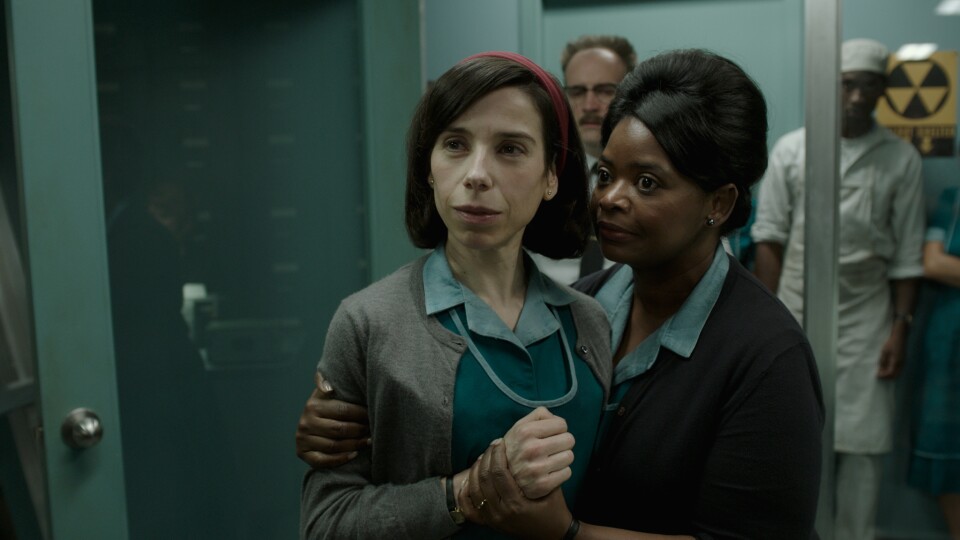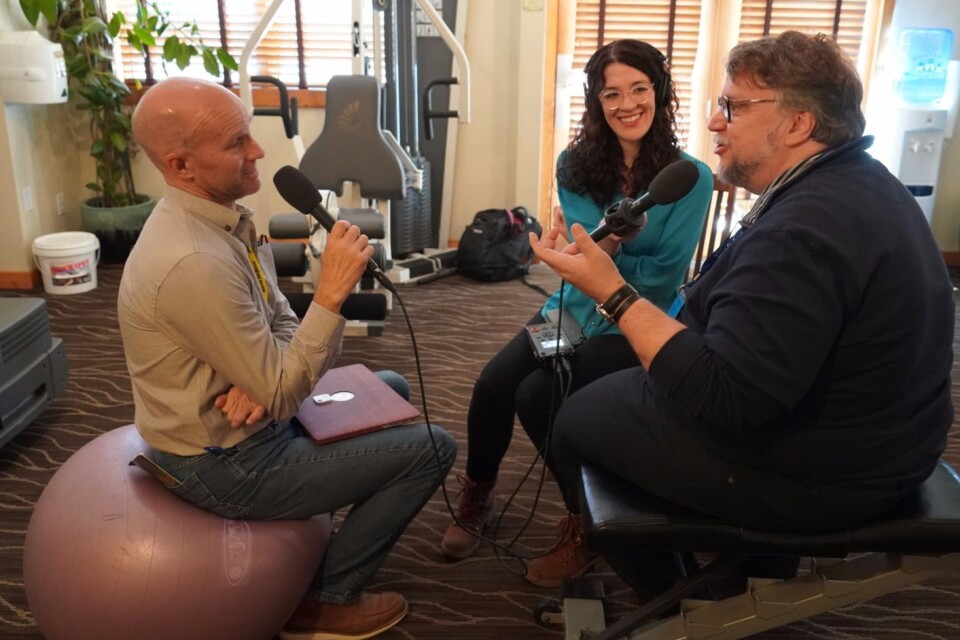From the diversity seen on the red carpet and onstage, to the pointed messages delivered during the ceremony, the movie industry is at a tipping point.
Backstage at the 90th Academy Awards
Awards season came to a close Sunday night at Hollywood's Dolby Theater. Many of the nominees made history.
Vanity Fair's Rebecca Keegan was perched backstage at the theater all week, from rehearsals to showtime. Keegan spoke to A Martinez about everything you didn't see on the telecast. The Frame's John Horn was also at the ceremony and joined in on the conversation.
Post-envelope gate worries
The envelope stack is getting smaller. Each time the accountant hands off an envelope to a presenter she says, “Confirming this is the envelope for (category name).” #Oscars pic.twitter.com/0AcJhGioxt
— Rebecca Keegan (@ThatRebecca) March 5, 2018
Last year's Best Picture announcement was a bit of a disaster, and it was something the Academy and Price Waterhouse accountants did not want happening again. Keegan said she saw some new protocol implemented this time around.
One of the things I noticed was that the accountant in the stage right wings, which is where the error was made last year, it was a new accountant and she was using what looked to me to be a different procedure.
When she would hand off the envelope she would say to the presenter, 'And this confirms that this is the envelope for the best actor category.' Also, if you looked at the envelopes, the font on them was enormous.
Me Too and Times Up movements make their mark
Salma Hayek, Ashley Judd, Annabella Sciorra held hands, whispered in conversation and Sciorra sang along to the performance of Stand Up For Something as they waited to take the stage. #oscars pic.twitter.com/YuipuSSp2w
— Rebecca Keegan (@ThatRebecca) March 5, 2018
The issue of inclusion was woven throughout the show from the very beginning of Jimmy Kimmel's monologue, all the way through to the end, with Guillermo Del Toro's speech acknowledging his status as an immigrant.
But it was the trio of Weinstein accusers consisting of Salma Hayak, Annabella Sciorra and Ashley Judd that Keegan recalled as the pivotal moment of the Times Up and Me Too moment.
I had watched them do this in rehearsal and it was very emotional, particularly for Annabella Sciorra. In rehearsals, she stepped to the microphone and began to read her script and just stepped back and said, 'Whoa.'
These are three women who have made allegations of sexual misconduct against Harvey Weinstein. In some cases, their careers have been really affected by that, and here they were on the film industry's biggest stage.
Another woman responsible for perhaps the biggest moment of the night was Frances McDormand's Best Actress acceptance speech.
https://www.youtube.com/watch?v=-86vgvZGMs4
McDormand introduced the world to a new word, "inclusion rider." It's a concept that was new to even her. Keegan spoke to one of the women behind the concept, which essentially means:
The idea is that if an actor has a rider where they can say, 'Hey I want my makeup artist with me on this movie...' they can have an inclusion rider and the suggestion that the folks at USC have made is that this inclusion rider mirror the general public.
In other words, your set — including the crew and background actors — will be 50/50 male/female, 40 percent people of color, 5 percent LGBT and 20 percent people with disabilities.
For more on the growing change in Hollywood, be sure to read The Frame's coverage of the 90th Academy Awards. You can find it here.
Oscars 2018: Change is clearly in the air in Hollywood
Guillermo del Toro's 'The Shape of Water' brings the filmmaker to tears
UPDATE: Guillermo del Toro's "The Shape of Water" won best picture at the 2018 Academy Awards and he also took home the directing trophy.
ORIGINAL STORY: Guillermo del Toro has always been interested in monsters. But unlike a lot of filmmakers, he doesn’t usually cast his creatures as villains. That holds true in his newest movie, “The Shape of Water.”
The film is a sympathetic look at — and even a love story about — a gilled, semi-amphibious creature from the Amazon who becomes the object of romantic fascination by a mute cleaning woman named Eliza (played by Sally Hawkins).
When asked about his choice to make the film's female lead unable to speak, Del Toro is very clear: "I think when you fall in love, love renders you mute. You can tell someone how much you love them all day long, but it's insufficient."

For del Toro, there is a very strong correlation between love and the movies — and its not that far of a stretch to say that all of his films are love stories.
"The essence of love is seeing. That's what love has in common with cinema. When I see you, I grant you your existence as a human being. When I see you as you are. I don't see you as a reporter. I see you as John Horn. I'm giving you a moment of love. This is the most loving thing."
I've interviewed Guillermo del Toro many times, but never in a hotel gym. That's exactly what we did when we caught up between screenings at the Telluride Film Festival. The Hotel Telluride was gracious enough to allow us to commandeer the place as it was the quietest room around to talk with the wildly imaginative filmmaker about his beloved new film. It's a movie that still brings him to tears (more on that later) and which he was willing to sacrifice his pay to make.

INTERVIEW HIGHLIGHTS:
On seeing 'Creature from the Black Lagoon' as a child:
In a strange way, "Creature" is an off-shoot of "King Kong." And "King Kong" is an off-shoot of "Beauty and the Beast" and the fascination with gorillas in the 19th century ... But what I loved about it — I was six years old, watching ["Creature"] on TV and three things awakened in me: one that I shall not disclose; the second one was, I thought it was the most beautiful image I'd ever seen. I had the Stendahl Syndrome moment, in which I was overwhelmed with beauty; and the third one I felt, I hope they end up together. And they didn't ... It took me 40-something years and 25 years as a filmmaker to correct that cinematic mistake.
On his adaptation of "Creature":
That was the point of ["The Shape of Water"] for me: the celebration of otherness, which I think is very timely. Also, the idea that we are controlled by fear right now. We are divided by fear. I wanted to make a movie about love, which sounds disingenuous because right now cynicism sounds smarter.
I happen to say, Let's make a movie that is so full of certain innocence — not stupidity, innocence — and recuperate the notion that love, like water, has no shape, but can cut through everything and take the shape of anything you need.
On crying at his own films:
It happens with "Pan's." It happens with "Devil's Backbone." Funnily enough, it happens with "Hellboy" and it happens with this one. In those movies there is the moment of the Stendahl Syndrome in all of them. There are moments of beauty that are purely cinematic and probably purely affecting me, that move me, because these are things I cannot express with words. Otherwise I wouldn't make movies and it affects me in a very deep way.
On his connections with the characters:
I'm every character, but if I have to choose I'm half the creature and half Sally, because there is a certain enchantment with the way Sally sees the world, which is the way I see movies. So, to me, love and cinema are indistinguishable from each other. And that's what the movie and Sally are about.
On how he relates to actors:
First of all, you tailor the part to them. I wrote it for Sally Hawkins. I wrote it for Michael Shannon. I wrote it for Octavia [Spencer], for example ... I'm tailoring it to their strengths, or what I perceive are their strengths. Then you have three weeks of rehearsal, in which the actor/director relationship is not one. Some actors need a dad. Some actors need a friend. Some actors need an enemy. Some actors need a boss. You get to know them in those three weeks, then you know: This guy needs this, this woman needs this and is reacting to this. You don't talk to them about it, but you know what they need. Those things lift them. They need them in the moment.
Frances McDormand's 'inclusion rider' explained
Frances McDormand took home her second Oscar for best actress on Sunday night, and her impassioned acceptance speech set off a frenzy of Internet searches for the term, "inclusion rider."
The phrase was unfamiliar to a lot of people. In fact, McDormand, who was honored for her role in “Three Billboards Outside Ebbing, Missouri,” said she hadn’t heard the term until about a week ago.
So what is an inclusion rider, and how might it work? To get the answers to both questions, The Frame's John Horn rang up Linda Lichter. She’s a prominent entertainment industry lawyer who specializes in transactions and contracts.
Interview Highlights
Where the idea of an inclusion rider comes from:
The actual reference is to something that comes from [USC Annenberg School's] Stacy Smith, who's been doing a lot of research about women in the business. It's something that individuals can attach to an agreement that says that they want to have a certain concentration of women or minorities on their film. I don't know if anybody has accepted this, but it's certainly aspirational.
Who is in a position to insist on an inclusion rider:
I certainly think that anybody who is the actor or actress who makes the film "go," or makes the TV show happen, is somebody who can ask for this. I would think that it wouldn't be impossible for an independent film to do it. Obviously it happened on [films] like "Mudbound" and others along that line. The real pressure will be on the major studios to do it — and I think it'll take a while.
Why it's not just for actors:
I think it has to be producers and directors as well — the people who make a lot of the hiring decisions. I think it also has to be agencies and other people that promote people, because I've been in situations where we ask for lists of writers from agencies and there wasn't a single woman on the list. So we have to have — at every level of the pipeline — an awareness that we need to bring in new voices.
How better representation can increase box office sales:
Apart from the fact that women are 51% of the population, they're 52% of moviegoers and they're 51% of movie tickets purchased ... So we've got an audience argument and we've got research about who it is that makes choices about what movies to go to and what things to buy, that I think should be persuasive. It's a slow process, but I think it's going to be motivated by economics as well as passion and politics.




